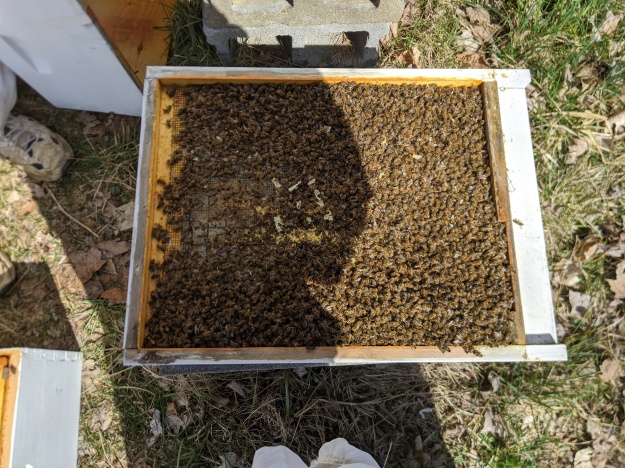My prayer is that all who read this post are well. My blog has been inactive for almost two months. I couldn’t write. There was just too much sadness. With all the grief and loss in the world, writing a light hearted post about bees felt irreverent. This spring has been one of the prettiest in recent memory. My periwinkle, phlox, tulips, daffodils, crocuses, and hyacinth all put on a grand show, but I didn’t take any pictures. Photography also felt irreverent. The blooms were comforting, though, in the same way a vase of a flowers is comforting when you stand by a casket.
At some point during this quarantine I became so overwhelmed with all the grim news headlines and hateful rhetoric that I contemplated not talking anymore. I was ready to retreat into a self imposed period of silence because I didn’t have the words to express my overwhelming feelings of grief for the suffering around me. You may have realized from the title of my website that I am married. It isn’t really fair to your spouse to make a unilateral decision to stop speaking especially during a quarantine. Not knowing what else to do I Googled “depression” and realized that I was exhibiting 6 out of 8 signs of depression. It was at that point I decided to start prioritizing mental health during this pandemic. I hope all of you have been doing whatever you need to do to care for your mental health as well. Here is what I did:
- Limit the number of times I read the news each day.
- Seek out uplifting things to watch on YouTube. My favorites have been the Cincinnati Zoo & Botanical Garden flower show, Dolly Parton reading children’s bedtime stories, and the MIGardener. I also found a TV station that plays Hee Haw re-runs.
- Try to find at least one thing to do every day to help someone else.
- Work in the garden. I will harvest my first radish crop next week.

Forte slows my progress in the garden. He always drops his ball at the edge and waits for me to throw it.
The bees are doing fairly well. We went into the winter with seven hives. We checked all seven hives on a warm day in March, and all the bees looked great. One week later we lost a hive. We did a post mortem. (Check out this post if you don’t know why beekeepers spend so much time looking at dead bees.) We are fairly certain the bees simply froze. When we opened the hive, the queen was still there along with about 100 live bees. Thousands of bees were in the bottom of the hive. When we looked closer, we realized many of those bees on the bottom were not dead but were in the process of dying. They could only move their wings and legs slightly. The heap of bees were concentrated on one side of the hive. The previous night had been very cold. Our best guess is that the bees unfortunately decided to cluster on the side frames instead of in the center of the hive. The hive wall would have been very cold, and the cluster probably couldn’t stay warm.

This was the pile of nearly dead bees we found at the bottom of one of our hives in early March. We think the very sudden cold snap the night before caused their demise.
Doug took the loss hard. We had done everything we could possibly do for these bees short of tucking the bees in for the night and reading them a bedtime story. The bees died anyway. I reminded Doug that at this same point in time a year ago we had three hives. Now we have six. In the beekeeping statistic world, we didn’t really lose a hive of bees. We had a 100% increase.
The April hive checks have gone well. The six remaining hives look good. However, we did find that two of the hives are now without queens. The number of bees in the hives is about the same, so we don’t think the queens left with swarms. Our best guess is one of two things happened: 1) The queens were inadvertantly injured during a hive check or 2) The queens were weak due to the formic acid mite treatment we did last fall. The formic acid mite treatment seems to be effective against mites but also very hard on the bees. We read that it is fairly common to lose a queen after treating a hive with formic acid. We won’t be using formic acid this year. We will probably switch to some type of oxalic acid treatment for varroa mite control. Fortunately we were able to discover our queenless hives pretty early. We moved frames of eggs over to the queenless hives so the bees can make their own queens. We have been more successful when we allow the bees to make their own queens rather than purchasing and installing queens. I think the bees want to have self determination and don’t want to have an outside monarchy imposed on them.
The bees are bringing in honey, and we think that this may be the year that we are able to extract honey and overcome our shameful beekeeping secret. (Click here for that post.)
Our bulk order of native grass seed and wildflower seeds arrived this week. Hopefully covid-19 won’t delay the work we are doing to create our large scale pollinator habitat. (See the plans for the habitat here.) It is still too cold to start eradicating the bush honeysuckle. Hopefully we can start that work in May, but we are taking things one day at a time as covid-19 alters everyday life.
One other bright spot this spring has come from the dandelions. I wanted fresh vegetables but didn’t want to go to the grocery store since grocery shopping has now become a dangerous affair. I remember stories of great grandparents eating dandelion greens, so I decided to try for myself. I pulled dandelions from the flower bed. I washed the leaves and soaked them in salt water. Next I boiled them for a few minutes and then added them to a skillet with sauted onions and garlic. The greens were delicious. They are also nutritious, free, and plentiful. Next I tried making dandelion tea, and I really liked it. Boil about 2 quarts of water. After the water comes to a boil, remove from heat, and add about 4 cups of washed dandelion blooms. I also add 1/2 teaspoon of dried mint, but you could add any spice that suits your taste. Let the tea sit for about 30 minutes and then strain. I keep it in the refrigerator and drink cold, but you could drink the tea hot. I really like the taste and don’t add any sweetener. You could add sugar or honey if you wanted to do so.
No matter what circumstances you are facing right now, I hope you are able to find some peace and comfort. I take courage from my dog Carmen. She is a rescue dog. I don’t know her history, but I don’t think it was pleasant. Now that Carmen is with us, she is a happy dog and never lets a patch of warm sunshine go to waste. She has come through difficult trials and has learned to savor life’s small pleasures. Be well and stay safe.



Thanks for expressing so well what we all need to hear.
LikeLiked by 2 people
You are doing so well with your bees. I’m glad you have been taking care of yourself and are able to write again.
LikeLiked by 2 people
Thank you. I hope you are well and staying safe.
LikeLike
Stay safe. This has been a time to take notice of what is important in our lives. Rescue dogs and bees are at the top of my list. Peace.
LikeLiked by 2 people
Lighthearted posts are not irrelevant in a world that needs to have some lightheartedness. I find that if I blog when I do not feel like blogging that by the time I am finished blogging I feel like blogging. I always enjoy reading yours.
LikeLiked by 2 people
Thanks, Leonard. Those are wise words. Stay safe.
LikeLiked by 1 person
Nice to see you posting again – be well!
LikeLiked by 1 person